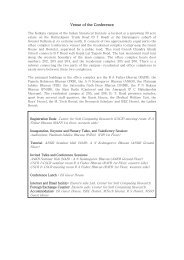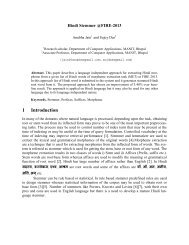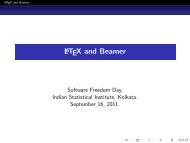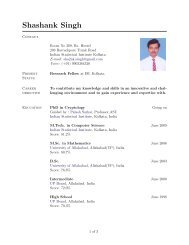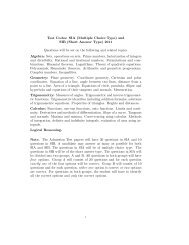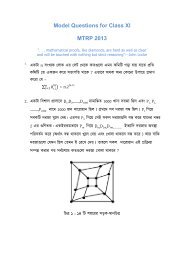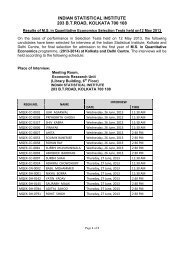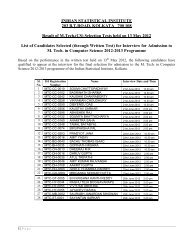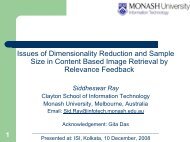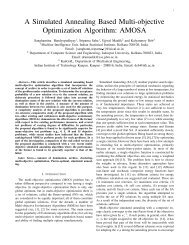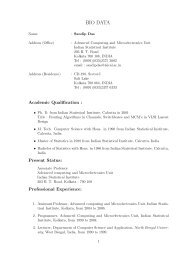Rule-based Stemmers for Bengali and Hindi - Indian Statistical ...
Rule-based Stemmers for Bengali and Hindi - Indian Statistical ...
Rule-based Stemmers for Bengali and Hindi - Indian Statistical ...
You also want an ePaper? Increase the reach of your titles
YUMPU automatically turns print PDFs into web optimized ePapers that Google loves.
ship to get the stem friend, a simple suffix removal does not suffice to normalizethe word enmity to enemy. Exceptions thus need to be <strong>for</strong>mulated <strong>for</strong> a set ofwords. Despite the limitations, the most widely used stemmers in English arethe rule-<strong>based</strong> ones viz. Porter stemmer [1] <strong>and</strong> the Lovins stemmer [2].For <strong>Indian</strong> languages, which are more inflecting in nature than English, themost commonly used stemming approaches have been the corpus-<strong>based</strong> one [3,4]. The only reported work involving rule-<strong>based</strong> stemming <strong>for</strong> <strong>Bengali</strong> is [5].However, there has not been any reported work seeking direct comparison betweenthe stemming approaches i.e. applying the different stemming approacheson the same document collection <strong>and</strong> query set, <strong>and</strong> comparing the retrieval effectivenessobtained by each. The Morpheme Extraction Task (MET) inceptedin FIRE-2012 is an attempt to achieve a fair <strong>and</strong> direct comparison betweendifferent stemming approaches.In this paper, we describe our participating systems in the MET-2012. Wedeveloped two rule-<strong>based</strong> stemmers <strong>for</strong> <strong>Bengali</strong> <strong>and</strong> <strong>Hindi</strong>. The rest of the paperis organized as follows. Section 2 describes the related work which is followedby Sections 3 <strong>and</strong> 4 describing the rules <strong>and</strong> how are they applied <strong>for</strong> <strong>Bengali</strong><strong>and</strong> <strong>Hindi</strong>. Section 5 evaluates the proposed stemmers by presenting the officialresults. Finally, Section 6 concludes the paper with directions <strong>for</strong> future work.2 Related WorkStemming approaches can be classified into different categories, e.g. by the resultsproduced by the stemmer (light stemming [6] vs. aggressive stemming [2]) or bythe resources used (corpus-<strong>based</strong> [7] vs. dictionary-<strong>based</strong> [8]).The most widely used stemming approach <strong>for</strong> English is the rule-<strong>based</strong> Porterstemmer [1], which successively applies rules to trans<strong>for</strong>m a word <strong>for</strong>m into itsbase <strong>for</strong>m. The successive removal of affixes means that words with a recursivemorphological structure are reduced to their base <strong>for</strong>m, e.g. words such ashopelessness may be reduced to hope by removing the suffixes ness <strong>and</strong> less.Light stemming focuses on removing only a few but the most frequent suffixesfrom word <strong>for</strong>ms. Recently, light stemming has been researched as a less aggressivemeans to reduce words to their root <strong>for</strong>m. For English, the s-stemmer whichremoves only the -s, -es, <strong>and</strong> -ies suffixes from words <strong>and</strong> other light stemmingapproaches have been proposed (see, <strong>for</strong> example, [9] <strong>and</strong> [10]).YASS is a clustering-<strong>based</strong> suffix stripper which has been applied to documentsin English, French, <strong>and</strong> <strong>Bengali</strong> [3]. YASS identifies clusters of equivalenceclasses <strong>for</strong> words by calculating distance measures between strings. This stemmerrelies on multiple word lists which have to be extracted from documents,i.e. all words starting with the same character have to be collected in the sameword list in a scan over all documents.Xu <strong>and</strong> Croft [7] use a combination of aggressive suffix removal with cooccurrencein<strong>for</strong>mation from small text windows to identify stemming classes.This technique is corpus-<strong>based</strong> <strong>and</strong> requires little knowledge about the document



